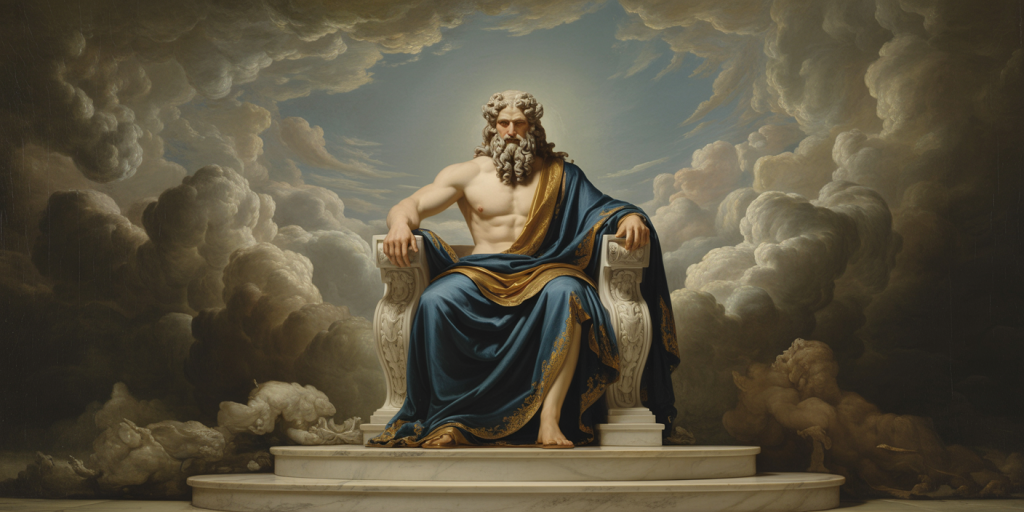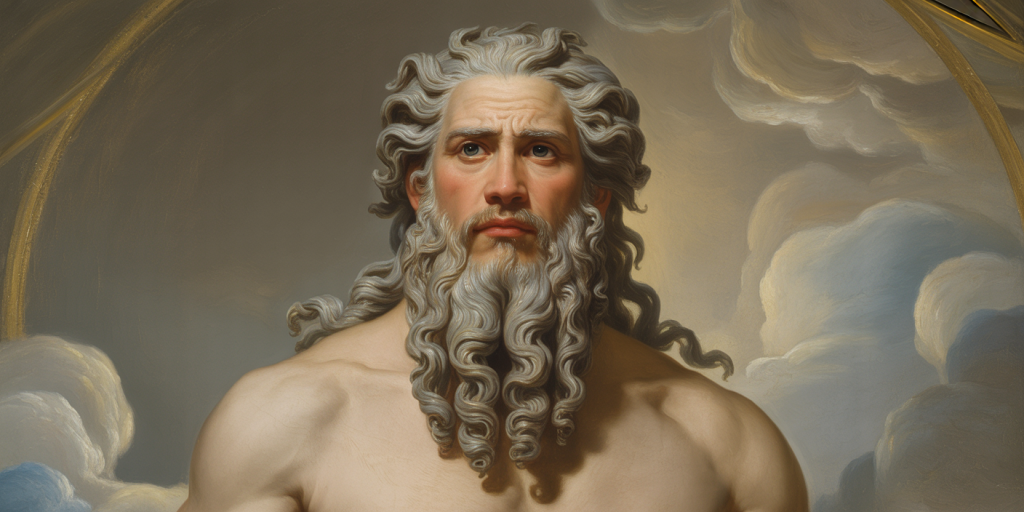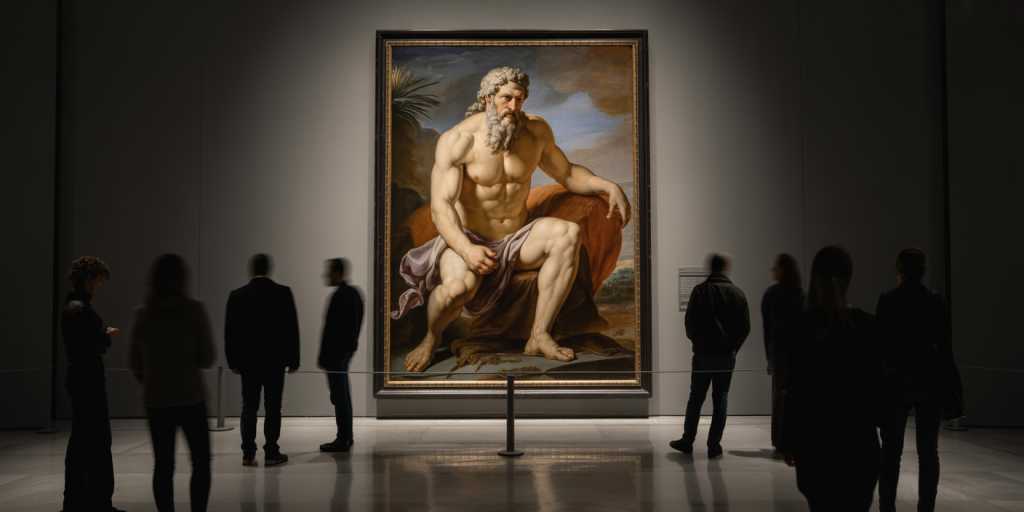Zeus in Silence: The Invisible Force in the Heavens by Ingres
High above the earthly din, where the clouds whisper omens and thunder slumbers, there dwells a presence that commands without motion. In Jean-Auguste-Dominique Ingres’ depiction of Zeus—majestic, silent, and immovable—the heavens themselves seem to bow in deference. It is not the clamor of battle or the lightning bolt hurled in fury that defines him here. It is restraint, gravitas, the dense atmosphere of divine thought. One does not hear Zeus. One senses him.
This Zeus is not the roaring god of tempest and passion but the still center around which all mythic turbulence turns. He is the calm eye of cosmic order, carved not in thunder but in the marble of silent authority. Ingres, master of line and illusion, gives us not the storm but the weight before the storm—the breath held in Olympus, the hush before the decree.
Table of Contents
- The Gaze That Anchors the Sky
- Shoulders of the Invisible Cosmos
- The Gravity of Stillness
- Drapery as Commandment
- The Lightning Beneath the Surface
- Eyes Like Sealed Vaults
- The Curve of Control
- Symmetry and the Sacred Axis
- Flesh as Monument
- A Throne Built of Clouds and Law
- Gold as the Temperature of Power
- Hair That Holds the Storm
- Light Without Fire
- The Iconography of Absolute Order
- Texture of the Untouched
- Muscles That Do Not Move
- The Aura of the God Unspoken
- Authority as Silence
- Zeus as Mirror of Kings
- The Echo Behind the Clouds
The Gaze That Anchors the Sky
Zeus’s gaze does not wander. It descends. Fixed and focused, it becomes the pillar upon which the entire composition balances. There is no tenderness, no curiosity—only decree. It is a gaze that sees through pretense and halts chaos, anchoring the visual and spiritual weight of the canvas.
Shoulders of the Invisible Cosmos
His shoulders are not just anatomical forms; they are mythic load-bearers. Ingres renders them with a softness that belies their conceptual mass. These are the shoulders that carry the unspoken laws of the heavens—not Atlas’ burden, but the tension of divine order.
The Gravity of Stillness
In a world intoxicated with motion, Ingres paints Zeus as unmoved. This stillness is not absence but authority. It is the gravity of sovereignty—a force so total it need not act. The lack of gesture becomes, paradoxically, the ultimate gesture.

Drapery as Commandment
The folds of Zeus’ garment are architectural—not merely fabric, but edicts carved into cloth. Ingres imbues each fold with deliberation. They do not flutter or yield but fall in divine precision. The drapery becomes law incarnate, sculpted in pigment.
The Lightning Beneath the Surface
There are no bolts in Zeus’ hand, yet lightning crackles beneath the canvas. It dwells in the tension of sinew, in the flicker of bronze light on muscle. Ingres paints potential, not explosion. He makes the viewer wait—and in waiting, feel.
Eyes Like Sealed Vaults
His eyes do not reveal. They contain. Like ancient vaults, they house the mysteries of Olympus: justice, wrath, mercy, fate. Ingres darkens the gaze just enough to obscure emotion, turning them into portals of unseen storms.
The Curve of Control
Ingres was a master of the curve—and in Zeus’ body, every arc is assertion. The swell of the chest, the controlled bend of arm and knee, the gentle slope of the neck—all embody control held in abeyance. Nothing wavers. Nothing pleads.
Symmetry and the Sacred Axis
The composition is nearly symmetrical, and with intention. Zeus becomes the axis mundi, the center not only of the painting but of a cosmic diagram. Ingres evokes classical temples, where symmetry was not aesthetic but spiritual—a geometry of truth.
Flesh as Monument
His skin is not skin. It is marble warmed by divine blood. Ingres renders flesh with porcelain smoothness, devoid of blemish, turning the body into monument. This is not vulnerability; it is permanence sculpted in living light.
A Throne Built of Clouds and Law
The throne is barely detailed, shrouded in soft light and abstract shape. It seems more idea than object. Yet it holds Zeus with undeniable force. One feels it is carved not from matter but mandate, a seat of elemental command.
Gold as the Temperature of Power
Gold shimmers subtly throughout the composition—in robes, beard, crown. It is not opulent, but sacred. Ingres uses it like incense: not to dazzle, but to elevate. It warms the palette with divine temperature, sanctifying form.
Hair That Holds the Storm
Zeus’s hair and beard, flowing and coiled, seem to house weather. They are not mere attributes but storm-clouds in repose. Ingres paints each strand with care, curling them like mythic sigils, charged with latent thunder.

Light Without Fire
Light in this painting does not burn—it breathes. It grazes the forehead, pools in folds, traces the arm. Ingres avoids theatrical glare, choosing instead a diffused sanctity. It is the light of thought, of presence, of divine clarity.
The Iconography of Absolute Order
Ingres does not surround Zeus with attributes of chaos. There is no eagle, no thunderbolt, no writhing serpent. Instead, every visual symbol reinforces serenity, law, and hierarchy. His Zeus is iconography distilled—the embodiment of the unshakable.
Texture of the Untouched
The texture is paradoxical. It feels soft to the eye, yet untouchable. There is no invitation to the tactile. Zeus is removed by varnish, by aura. One may see his form, but not feel it. He is a vision behind veils of reverence.
Muscles That Do Not Move
The musculature is present but subdued. It does not suggest action but capacity. Ingres paints strength not as effort but as essence. These are not the bulging muscles of war but the poised readiness of eternity.
The Aura of the God Unspoken
Silence pervades the canvas. Not emptiness, but presence. It is the silence of temples, of ancient forests, of sky before lightning. Ingres composes a sacred hush, one in which divinity does not shout, but fills.
Authority as Silence
What makes this Zeus sovereign is not what he does but what he withholds. Authority, here, is restraint. Power is the ability not to act, but to be. Ingres offers us a meditation on leadership as inward gravity.
Zeus as Mirror of Kings
In Ingres’s time, monarchy was in question. This Zeus reflects not just ancient divinity, but contemporary political yearning—for stability, for right to rule, for inherited order. He becomes both myth and mirror, a divine figurehead in a storm-tossed world.

The Echo Behind the Clouds
Ingres leaves space beyond Zeus—clouds that hint at distance, sky that suggests depth. These are the echoes of Olympus, the breath of stories unspoken. The painting does not end with its frame. It reverberates beyond, like thunder withheld.
Frequently Asked Questions
Who was Jean-Auguste-Dominique Ingres?
Ingres (1780–1867) was a French Neoclassical painter known for his precise draftsmanship, smooth textures, and idealized forms. Though often at odds with Romanticism, his work holds deep emotional and symbolic resonance.
What is Ingres’ style?
Ingres practiced Neoclassicism, drawing from the art of ancient Greece and Rome. His work emphasizes clarity, balance, and idealized beauty. He used line as his primary tool, preferring it over expressive brushwork.
Which painting of Zeus is this article based on?
The article is inspired by Ingres’ lesser-known but profoundly symbolic depictions of mythological gods, especially his sketches and painted interpretations of Jupiter (Zeus), which embody the silent force of divine rule.
What differentiates Ingres’ Zeus from others?
Unlike dynamic, storm-wielding depictions, Ingres presents a Zeus rooted in stillness and control. His god exudes power through silence, form, and balance rather than action or spectacle.
Why is silence emphasized in this portrayal?
Silence becomes a metaphor for authority, wisdom, and the unshakable. It contrasts with the chaos of myth to highlight the divine as origin and order rather than disruption.
Notes from the Cloud-Crowned Throne
Ingres did not paint Zeus as the god of spectacle, but as the god of permanence. His canvas is not a battlefield, but a throne room of the cosmos. In it, every detail whispers of weight, of law, of the unspoken command that holds heavens aloft.
To gaze upon this Zeus is to feel judged and shielded, summoned and steadied. He is not merely a figure of myth, but a manifestation of silence so powerful that even thunder dares not follow.
In our world of endless clamor, Ingres reminds us: the greatest force may not be the one that strikes, but the one that simply remains.
